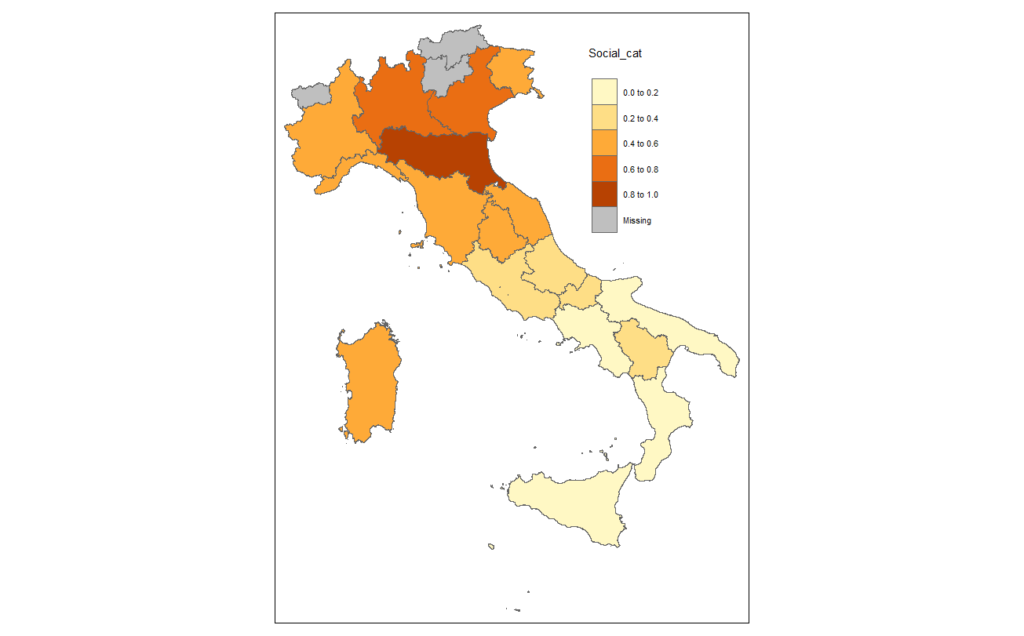Does Social Capital Affect Voter Turnout? Evidence from Italy
Fiorino N., Galli E., Pontarollo N., 2021 – Social Indicators Research
Paper presented at the 2018 SIEP Conference “Global structural changes and government challenges”, University of Padua
Since the second half of the last century, social capital has attracted increasing attention as a relevant factor underlying voting behavior in democracies. A bulk of literature has recognized that civic involvement, social connections, sharing common goals may play a crucial role in explaining differences in political participation. People who socially interact represent an important channel to transmit norms of civic and political participation and recruit other people in these activities.
Empirical evidence, mainly based on individual data or experiments performed on survey data in different countries, is mixed. Some papers find that social capital positively affects voter mobilization by strengthening co-operative behavior or increasing the flow of information. Others show that it discourages electoral participation by exposing citizens to conflicting views or providing them with an alternative channel to achieve personal goals and satisfaction. Overall, these mixed findings are the result of several issues: the difficulty to adequately and unanimously define a phenomenon which encompasses different dimensions, ranging from social networks to trust and civic norms; the subsequent complexity of translating these multifaceted definitions into a ‘good’ measure’; the methodological problems of omitted variables and endogeneity that may affect the electoral participation-social capital nexus.
In a recent study, Does Social Capital Affect Voter Turnout? Evidence from Italy, published on Social Indicators Research, focusing on the measurement of social capital, Nadia Fiorino, Emma Galli and Nicola Pontarollo develop a new composite indicator, named Social Catalyst, which presents two relevant advantages. First, it is able to account for the complex and multifaceted nature of the social capital in a unitary measure that captures the bundle effect (compositional effect power) of the different dimensions recognized by the literature. Moreover, it can be easily generalized to different contexts since the methodology used to build the indicator is not country-specific. The authors then use the new measure of social capital, as well as its components, to verify its (and their) impact on electoral participation in 5 national parliamentary elections from 1994 to 2008.
The Social Catalyst is a measure of social capital generated by a combination of networks/cooperation, social norms and trust as interlinked dimensions which, taken all together, depict the heritage of a community, consequently contributing to form a unitary concept. It is constructed through a normalization and weight elicitation which is based on Principal Component Analysis (PCA). This procedure allows to transform multiple dimensions into a set of uncorrelated dimensions and to reduce dimensionality.
The dimension of generalized trust signals the degree of honesty and integrity of a whole community and captures the relevance of general rules and values which dominate the entitlements of personal relationships. The authors proxy it with the variable Corruption exposure. The dimension of particularistic trust is captured using Blood donors and Associations. These variables depict, in slightly different ways, cooperation and social interactions. Whereas Associations relates to networks often motivated by expectations about the behavior of other individuals which create trust mostly among the members, Blood donors captures the humanitarian propensity to volunteering in favor of others. The dimension of social norms (civicness) is measured using the newspapers diffusion and TV license taxpayers. The variable Newspapers diffusion works as a channel that facilitates the transmission and sharing of information among citizens, strengthening their sense of membership to a community and their social participation. TV license taxpayers captures citizens’ tax morale and civic behavior with respect to a tax payment which is very weakly enforced. The identified components account for approximately 82.5% of total variance.
Figure 1 illustrates the distribution of the average values of the Social Catalyst by quintile. A clear geographical pattern appears. Northern regions show a higher social capital than Southern ones, confirming previous research on the Italian North-South divide with respect to social capital.

The empirical model estimates the effect of the Social Catalyst on regional voter turnout in the national parliamentary elections controlling for a number of demographic, economic and institutional variables. The model also addresses endogeneity problems through an IV identification strategy based on the use of an instrumental variable of historical nature, i.e., the number of city-states in each region. Indeed, the medieval experience of self-government stimulated social and political institutions that built mutual trust and cooperative norms over the long run, persisting to the present day.
The results show that the bundle effect identified by the Social Catalyst is strongly and positively correlated with voter turnout in both Chamber of Deputies and Senate. The authors also test the effect of individual dimensions of social capital on voting participation and find that, among these, social norms and civic sense, i.e., the particularistic dimensions of social capital, promote active citizenship; in contrast, electoral participation does not appear to be influenced by the general sense of community integrity and legality. Although corruption enters social capital as a relevant dimension, it does not affect electoral participation when taken separately. This result implies that the influence of corruption on electoral participation is mediated by the strength of social norms and the role of the press. In light of this evidence, the authors conclude that greater involvement in politics and trust in the electoral process are fostered by social norms and civic participation. In this sense, social cohesion policy, which, especially after the pandemic, has become increasingly central in both the EU and Italy, not only promotes a more equitable and socially sustainable growth process, but can also become an important channel for strengthening democracy and accountability.

